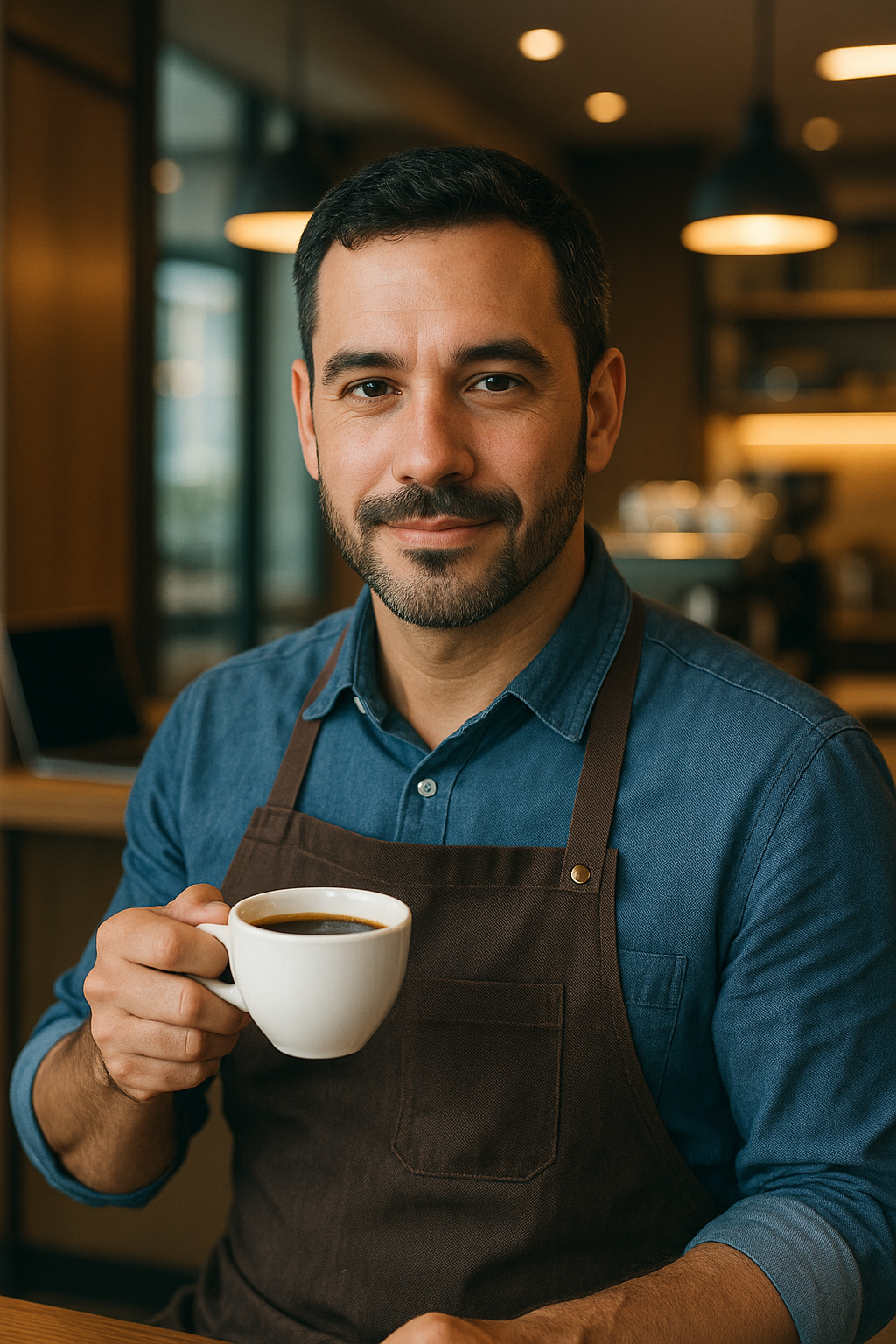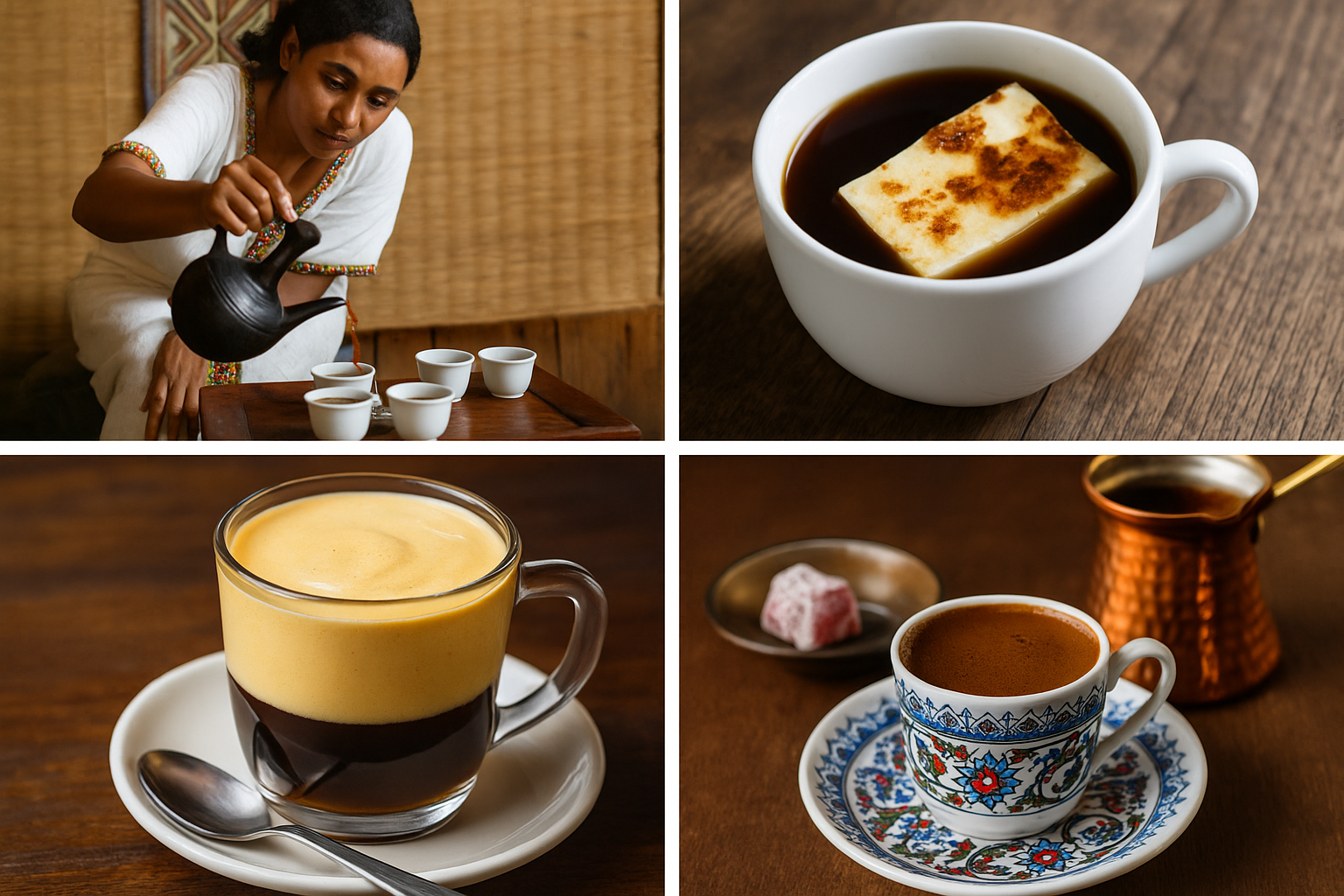Coffee is one of the most universally loved beverages, but how it’s prepared, served, and consumed varies dramatically across cultures.
While many people are familiar with a standard espresso or a cappuccino, there’s a whole world of coffee customs that may surprise you.
From eggs and cheese in your cup to elaborate ceremonies that span hours, each country has developed its own unique traditions that reflect local history, geography, and social norms.
In this article, we’ll explore some of the most unusual and fascinating coffee traditions from around the globe—showing just how diverse the world’s love affair with coffee really is.
Ethiopia: The Coffee Ceremony
In the birthplace of coffee, Ethiopia, coffee isn’t just a drink—it’s a ritual. The Ethiopian coffee ceremony is an important cultural event and a symbol of hospitality and community. It can take hours and involves roasting green coffee beans over an open flame, grinding them in a mortar, and brewing them in a traditional clay pot called a jebena.
The coffee is served in three rounds: abol, tona, and baraka, with each round symbolizing deeper connection and respect among the guests. Incense is often burned during the ceremony, and popcorn or roasted barley is served as a snack.
Sweden: Fika – A Social Coffee Break
In Sweden, the concept of fika is so deeply embedded in daily life that it’s more of a cultural institution than just a coffee break. Fika involves taking a moment—often with colleagues, friends, or family—to relax and enjoy coffee, usually paired with a pastry like a kanelbulle (cinnamon bun).
It’s not just about caffeine; fika is about connection, mindfulness, and balance. Many workplaces even schedule fika time into the day. The Swedish belief is that taking time to pause can actually boost productivity and happiness.
Vietnam: Egg Coffee (Cà Phê Trứng)
Eggs and coffee might sound like a strange pairing, but in Vietnam, egg coffee is a beloved specialty. It’s made by whipping egg yolks with sugar and condensed milk into a creamy, meringue-like foam, which is then poured over strong Vietnamese drip coffee.
This drink originated in Hanoi in the 1940s, when milk was scarce and eggs were used as a substitute. The result is sweet, rich, and dessert-like. Egg coffee can be served hot or cold and is often enjoyed as an afternoon treat.
Finland: Coffee and Cheese (Kaffeost)
In Finland, especially among the Sámi people in the northern regions, there’s a unique coffee pairing: kaffeost, which translates to “coffee cheese.” This involves cubes of a squeaky, mild cheese called leipäjuusto being placed in a cup, then coffee is poured over them.
The hot coffee softens the cheese, which is eaten with a spoon after the coffee is drunk. It may sound odd to outsiders, but it’s considered a comforting and nostalgic combination in northern Finnish culture.
Turkey: Thick Brew, Fortune Telling, and Tradition
Turkish coffee is famous for its intense flavor and thick, unfiltered consistency. Made in a cezve, a small copper pot, the finely ground coffee is brought to a boil multiple times before being poured into small cups.
It’s traditionally served with a glass of water and something sweet, like Turkish delight. Once the coffee is finished, the remaining grounds in the cup are often used for fortune telling—a practice known as tasseography.
UNESCO even designated Turkish coffee as part of the Intangible Cultural Heritage of Humanity, highlighting its historical and social importance.
Saudi Arabia: Coffee and Dates With Generosity
In Saudi Arabia and other Gulf countries, coffee is served with strong cultural symbolism. Known as qahwa, the coffee is lightly roasted and brewed with cardamom, sometimes also with saffron or cloves.
It’s poured from a dallah (a traditional coffee pot) into small handleless cups called finjan, and usually accompanied by dates. The act of serving coffee is a sign of hospitality and respect.
Refusing a cup of coffee in this context can be seen as rude, and cups are traditionally refilled until the guest signals they’ve had enough—usually by shaking the cup.
Senegal: Café Touba – Coffee With Spices and Soul
Café Touba is a spiced coffee drink popular in Senegal, named after the holy city of Touba. It’s made by brewing coffee with grains of Selim (also known as Guinea pepper), which adds a smoky, peppery kick.
Introduced by Sufi Muslims in the 19th century, Café Touba is often sold by street vendors and consumed in small shots. It’s not just a drink—it’s also part of a spiritual tradition, offering energy and focus for prayer and meditation.
Italy: The Espresso Ritual
While many know about Italy’s famous espresso, few understand how deeply it’s woven into daily life. Italians don’t linger over coffee—they drink it quickly while standing at a bar. Espresso is taken straight, short, and without milk after the morning hours.
Social etiquette dictates when to order certain drinks: cappuccino in the morning, espresso after meals, and never a milky drink after 11 AM. For Italians, the act of drinking coffee is about rhythm and ritual, not just flavor.
Morocco: Spiced Coffee With a Fragrant Twist
In Morocco, coffee is often brewed with warm spices like cinnamon, nutmeg, cloves, and cardamom, giving it a complex, aromatic flavor profile. It’s served strong and sweet, usually in small glasses, and is often enjoyed during social gatherings.
The influence of North African spice markets is evident in the drink’s flavor, which varies by region and household. Moroccan coffee is less known internationally but deeply cherished locally.
Japan: Artisanal Precision and Canned Coffee Culture
Japan has two coffee traditions that contrast beautifully. On one end, you have the kissaten, old-school coffee shops where pour-over brewing is done with obsessive attention to detail. Baristas time each pour and control water temperature precisely, producing a clean, elegant cup.
On the other hand, Japan also pioneered the canned coffee phenomenon. You’ll find a wide variety of canned coffee drinks—hot and cold—in vending machines all over the country, often available 24/7.
Both traditions reflect Japan’s dual love for precision and convenience.
Colombia: Tinto and Coffee on the Go
In Colombia, coffee isn’t just for export—it’s a cherished part of daily life. One popular drink is tinto, a small, sweetened black coffee often sold by street vendors. Tinto is affordable and accessible, making it a favorite among locals.
Despite being one of the world’s largest coffee producers, Colombians often reserve the best beans for export and drink more humble varieties domestically. That’s starting to change, though, as local pride in high-quality coffee grows.
Austria: Viennese Coffeehouse Culture
Austria’s capital, Vienna, is home to one of the most famous coffee cultures in the world. Viennese coffeehouses have been gathering places for writers, intellectuals, and artists for centuries.
A typical Viennese coffee drink is the melange, a mix of espresso and steamed milk, similar to a cappuccino. Coffee is often served with a glass of water and a small chocolate or biscuit, encouraging guests to linger for hours while reading or conversing.
These cafés are so important culturally that UNESCO listed Viennese coffeehouse culture as an Intangible Cultural Heritage.
Brazil: Cafézinho – A Gesture of Hospitality
In Brazil, a small, strong, sweetened coffee called cafézinho is offered to guests as a sign of hospitality. It’s typically served in tiny cups and can be found everywhere—from offices to train stations.
Though Brazil is the largest coffee producer in the world, most locals drink coffee made with paper filters, often lighter and sweeter than what’s popular in other countries. Cafézinho isn’t just a beverage—it’s a symbol of warmth and welcome.
Embracing Coffee’s Cultural Diversity
From elaborate ceremonies in Ethiopia to cheese-laced coffee in Finland, the world’s coffee traditions are as varied as they are fascinating. These rituals are about more than caffeine—they’re about identity, community, and heritage.
Understanding global coffee customs not only enriches your palate but also deepens your appreciation for a drink that brings people together in so many ways.
So the next time you take a sip, remember: there’s a world of coffee out there—waiting to be discovered, one cup at a time.

Marcelo Oliveira is a coffee enthusiast and content creator specializing in barista skills, brewing methods, equipment reviews, coffee-related health insights, and fascinating curiosities from the coffee world. With a deep passion for every step of the brewing process, he turns technical knowledge into accessible and engaging content for both beginners and seasoned coffee lovers. Marcelo’s goal is to help readers appreciate the full experience of coffee—from bean to cup.
